-
Content Count
1456 -
Joined
-
Last visited
Posts posted by cheeseman
-
-

If you go folks, remember to take some cheese for the photo shots!

-
Hi Cheesefans!
Time for a visit to Mexico for this week's Cheeseman's Cheese of the Week!
Oaxaca
Also known as Asadero, Oaxaca is a Mexican name of semi-soft, white, string-type, Hispanic-style cheese. This kind of cheese is used on sandwiches or melted on cooked foods, including pizza and nachos. It is a stretched curd cheese, kneaded then formed into a ball-shape which is plunged in brine for several minutes. It's name comes from the name of state in which it originates. It is a kind of pasta filata cheese and it is produced in different shapes and weights. This cheese belongs to the group of fromage forts cheeses made from mixed, fresh or riped cheese blended with herbs and spices.


-
Fine work Metabo Oyaji.
SJ I think this thread should be "pinned" to remind people to get those cheese pics.

-
Afternoon Cheesefans!
Time for a new Cheeseman's Cheese of the Week!
This week, over to France
---------
Munster or Munster-géromé, is a strong tasting, soft cheese made mainly from milk from the Vosges, between Alsace, Lorraine and Franche-Comté in France.
The name munster may come from the little town of Munster, where, among Vosgian abbeys and monasteries, the cheese was conserved and matured in monks' cellars. It may also refer to the Latin word for monastery, monasterium.
This cheese originated in the Admodiation, an area on the top of the Vosgian mountains, named Chaumes" or "Les grandes Chaumes" (comitatus Calvomontensis). Calvomontensis is the Latin word that describes mountaintops without woods.
As early as 1371, and possibly before, these territories were occupied by cattle herds driven by men, called "marcaires", pastured there between May and September. When the herds returned to their valleys, the cattle herdsmen first paid the fees and tithes to the religious and political owners of the summer pastures or simply financiers of this transhumance. During feudal times these owners possessed all goods, living creatures, rights of pasture and cattle. Those who herded were known as serfs.
This mountain population paid their debts with cheese and jars of butter. The lords were the first religious establishments, women like chanoinesses from Remiremont or from Andlau, or men such as the chanoines or canons from Murbach or Saint-Dié, Benedictines from Munster, Senones, Moyenmoutier, and other monastic areas. Political protectors, included the duke of Lorraine, count of Salm, count of Ribeaupierre, and other Alsatian noblemen.
During the 7th century, this tradition, though disappearing, was maintained in two special places, Gerardmer in the western Lorraine part of the main range and Munster for the east and Alsatian part. Hence the two names of this cheese, gérômé and munster written with little type.
Munster géromé is at its best in the summer and the autumn, when it is made from milk from the haute chaumes ("high stubble") of pastures that have already been mowed for midsummer hay in the Vosges mountains. The best cheeses come from the haute vallée de Munster itself, but this cheese is also made in Lapoutroie, Sainte-Marie-aux-Mines, Villé, and other villages practically or in western Vosges, in Lorraine. Now the tourism industry has supplanted farming near the lake's Valley near Gérardmer.
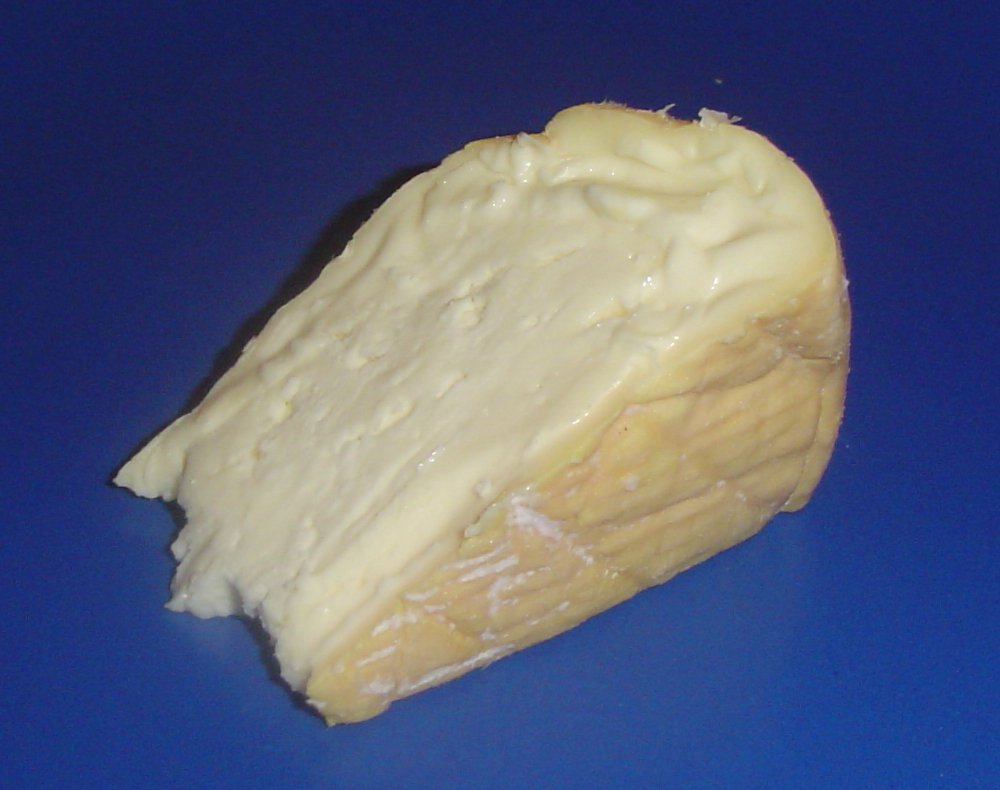
-
Hi Cheesefans!

Time for another Cheeseman's Cheese of the Week!
How about one that smells like body/food odor!!! Scratch the photo below to smell.
-----
Limburger is a cheese that originated during the 19th century in the historical Duchy of Limburg, which is now divided among modern-day Belgium, Germany, and Netherlands. The cheese is especially known for its pungent odor commonly compared to body odor.
In its first month, the cheese is firmer and more crumbly, similar to the texture of feta cheese. After about six weeks, the cheese becomes softer along the edges but is still firm on the inside and can be described as salty and chalky. After two months of its life, it is mostly creamy and much smoother. Once it reaches three months, the cheese produces its notorious smell because the bacterium used to ferment Limburger cheese and many other smear-ripened cheeses is Brevibacterium linens, the same one found on human skin that is partially responsible for body odor and particularly foot odor.
One of the most traditional forms of eating limburger is the limburger sandwich. After three months, when the cheese has ripened, it becomes spreadable. The cheese is often spread thick (> 0.5 cm) on firm-textured 100% rye bread, with a large, thick slice of onion, and is typically served with strong black coffee or lager beer. Alternatively, for heartier eaters, chunks or slices of the cheese up to 1.5 cm thick can be cut off the block and placed in the sandwich. This sandwich still remains very popular among the descendants of German immigrants residing in the midwest part of America, such as in Cincinnati, or German Village in Columbus, Ohio. However, it is markedly less popular among the descendants born after ca. 1960, mainly because of the permeating smell, and the inconvenience of going to specialty cheese and sausage shops to obtain it. In Wisconsin, the Limburger sandwich can be found on menus at certain restaurants, accompanied with brown mustard.
Limburger and its characteristic odor are a frequent butt of jokes and gags. In 2006, a study showing that the malaria mosquito (Anopheles gambiae) is attracted equally to the smell of Limburger and to the smell of human feet earned the Ig Nobel Prize in the area of biology. The results of the study were published in the medical journal "The Lancet" on the 9th of November, 1996.
A 100 gram serving of Limburger contains about 327 calories (1,370 kJ) and has 27 grams of fat, which is about 42 percent of the daily value of a person eating on a 2,000 calories (8,400 kJ) per day diet. Although it does provide calcium, protein and Vitamin A, it also makes up for 30 percent of the daily value of cholesterol and 33 percent of the daily value of sodium. This assumes eating 3.5 servings of the cheese.
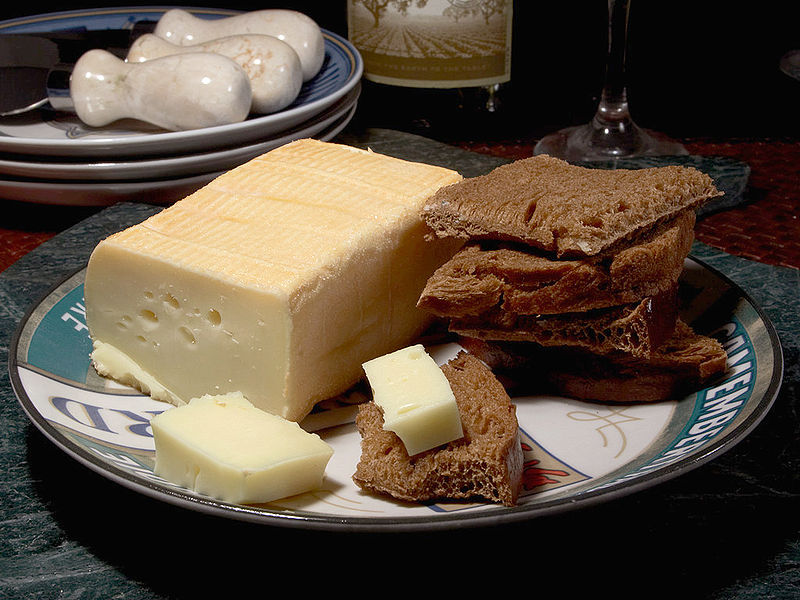
Limburger cheese has the distinction of being the most pungent cheese in the world. It originated in Belgium but is now made mostly by the Germans. It has a soft, creamy texture and a taste that's earthy, almost meaty in flavor. Although many people swear by the taste, a high regard for the odor definitely must be acquired. The famous aroma is due to enzymes breaking down certain proteins which lie on the surface of the cheese giving rise to what can only be described as a "stinky" odor.
-
Hi Cheesefans!
It's time for a new Cheeseman's Cheese of the Week!
This week... Vacherin
Vacherin is a cow's-milk (French vache, "cow") cheese. Two main types of French or Swiss Vacherin cheeses exist.
One is a soft, rich, seasonal cheese made from cow's-milk in Switzerland or France, usually in villages of the Jura region (an origin that has been officially controlled since 1981), and has a grayish-yellow washed rind and is called Mont d'Or, or Vacherin du Haut-Doubs, from France, or Vacherin Mont d'Or from Switzerland (though it tends to just be called Vacherin in the local shops). It typically contains 45 to 50 percent milk fat (in dry matter), and is produced between August 15 and March 15, and sold between September 10 and May 10, and the Swiss Vacherin Mont d'or is generally made with pasteurised milk, while the French Vacherin du Haut-Doubs is unpasteurised. It is marketed in round boxes of various diameters made of spruce. It is often served warmed in its original packaging and eaten like a fondue.
Officially, the French AOC/PDO allows Artisanal and Coopérative production of Mont d'or.

-
Very good pie-eater.
Did you get much cheese in then?
-

Very good work Mich Rick.
I hope we see lots of different cheeses at lots of resorts this coming season.
Remember folks, take the cheese and take the shot!

-
Hi Cheesefans! Time for Cheeseman's Cheese of the Week thread to start again.
I had a good summer and lots of cheese.
Really enjoyed the cheeses in Holland, good old Gouda and it's variations were nice.
Gouda is an orange cheese made from cow's milk. The cheese is named after the city of Gouda in the Netherlands, but its name is not protected. However, the European Commission has confirmed that "Gouda Holland" is to be protected (although "Gouda" itself is not). Cheese under the name of Gouda is currently made and sold all around the world.
The cheese is from cultured milk that is heated until the curds separate from the whey. Some of the whey is then drained, and water is added. This is called "washing the curd", and creates a sweeter cheese, as the washing removes some of the lactic acid. About ten percent of the mixture are curds, which are pressed into circular moulds for several hours. These moulds are the essential reason behind its traditional, characteristic shape. The cheese is then soaked in a brine solution, which gives the cheese and its rind a distinctive taste. The cheese is dried for a few days before being coated to prevent it from drying out, then it is aged. Depending on age classification, it can be aged a number of weeks to over seven years before it is ready to be eaten. As it ages, it develops a caramel sweetness and sometimes has a slight crunchiness from salt-like calcium lactate or tyrosine crystals that form in older cheeses. After 24 months of aging, sodium chloride crystals start to form around the outside casing of the cheese. These crystals are usually removed with a soft cloth.
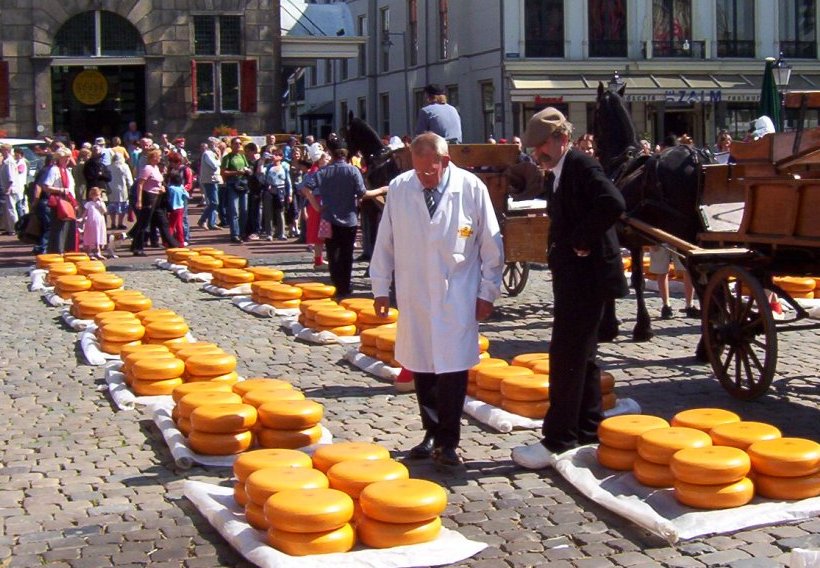
-
Don't leave cheese out for a few days in this heat.
Beginners mistake!

-
Ireland anyone?
Yes, that's where we will go for this week's Cheeseman's Cheese of the Week!
Croghan
Semi-soft, vegetarian, goat milk cheese of round shape. The smooth, brine-washed leathery rind is brown-pink to terracotta in color and has some mould. This cheese is made by Luc and Anne Van Kampen and the production is loosely based on Gouda. The flavor of the cheese suggests grass and hay, while the finish is aromatic without being pungent. It is made only from spring to autumn and the period of maturing is from four to 12 weeks.

Nice one.
-
The price of cheese in Japan.... taihen desu ne!
-
I don't think I will ever get used to, or begin to like, natto.
-
Someone brought be some Leicester recently and I really enjoyed it. So let's recap on that cheese today Cheesefans - in this week's Cheeseman's Cheese of the Week!
---
Leicester
A natural hard cheese. The bright, orange-red rind has fine, powdery moulds. Raspy, moist-textured, Leicester is made in a similar fashion to Cheddar and comes covered in a hard, dry rind. Leicester has a rich, mild flavor with a flaky texture and a deep orange color, due to natural dye annatto. Traditional makers of Red Leicester include Quicke and Overton Hall. This cheese can be eaten young, but it should ideally be left to mature for six to nine months. This cheese is excellent with fruit and beer.
Here's some red leicester

-
Time for a new Cheeseman's Cheese of the Week, cheesefans.
Where this week?
How about Italy?
---
Asiago
Asiago is made in the region of Vicenza and Trento. It is a traditional, farmhouse and creamery, unpasteurized, hard cheese. Originally made of ewe's milk, now is made entirely of cow's milk. There are two types of Asiago: first one (mistakenly taken for Pressato) is a lightly pressed cheese made from whole milk matured for 20-30 days. Another one (Asiago d'Allevo) is the mature cheese made with skimmed milk. Long and slow maturation process creates fruity, slightly sharp cheese with a compact, granular interior full of small holes. Matured over 2 years, becomes intensely flavored. Can be grated and used as a condiment.

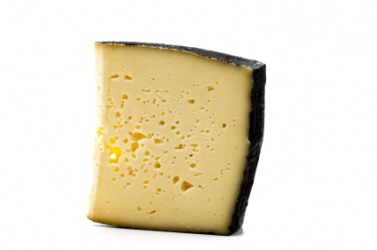

-
We live on a similarly quiet road that hardly anyone other than the people living here use.
There's lights that are really not necessary and actually since last year they have had them turned off. No-one is the worse for it. I hope they don't decide to put them back on because one light affects our living room and I much prefer it not being on.
-
Afternoon, Cheesefans!
It's time for another Cheeseman's Cheese of the Week!
How about this on, from Mexico
Cotija
It is a Hispanic-style cheese, known as the "Parmesan of Mexico". It was originally made with goat's milk but today cow's milk is preferred. This cheese is strongly flavored, firm and perfect for grating. It is used in Hispanic cooking, in a manner similar to the way Parmesan is used in Italian cooking. Cotija is commonly used to add a lively garnish to common dishes: simply sprinkle on top of refried beans, salads, chili or lasagna. In Mexico, it is also widely used to enhance the flavor of many savory dishes by mixing directly into the casserole or recipe. In the U.S. it is increasingly popular on pasta. See for yourself how much zestier any pasta or even simple macaroni and cheese will taste with a sprinkle of Cotija. It is typically shredded onto cooked foods, also in salads and with fruit.

Looks good doesn't it.
I only tried it once.
-
How about a Cheese and Wine tabe-nomi-hodai?
Doesn't that sound the best?
-
They should eat more cheese.
Not only is it delicious, but also nutritional... and fun for all the family.

-
Hi Cheesefans!
Time for Cheeseman's Cheese of the Week.
Fancy a "Brick"?
Brick
Brick's roots lie in Wisconsin at the end of the 1800's. Its name is perhaps derived from early moulding techniques, the pressing of the cheeses with actual bricks. The cheese has a number of small and irregular holes and an open texture. It suggests a mixture of sweet, spicy and nutty flavor. Brick tastes delicious with any kind of fruit, crackers, wine, beer or apple juice.

Anyone tried that?
-
Good morning Cheesefans.
OK it's time for a new Cheeseman's Cheese of the Week. This week, let's go over to Ireland. I really like this one.
Ardrahan
Modern, farmhouse, vegetarian, washed-rind cheese made from cow's milk. It usually has a wheel shape. The ridged, brine-washed rind is encrusted with brown, ochre, gray and yellow moulds. Ardrahan is made by Eugene and Mary Burns. It has a distinctive, earthy aroma. Beneath the brine-washed rind, the deep yellow interior is firm and slightly chalky. It exudes a wonderful complexity of flavors, the zesty acidity underscoring the buttery, savory, meaty character. The finish is reminiscent of a young Gruyere. The cheese matures in four to eight weeks.


So many cheeses, so little time!
-
We managed 3 weekends and a few day trips.
-
Another person who didn't post here!
Cheeseman - ski
Cheesewoman - ski and board
Cheeseboy - ski
Cheesegirl - ski
Cheesedog doesn't ski or board.

-
Morning Cheesefans. It's time for a new Cheeseman's Cheese of the Week!
This week let's do a lesser well-known English cheese, I tried this once and it was very good.

Beenleigh Blue
Modern, farmhouse, unpasteurized, organic, vegetarian, blue cheese made from sheep's milk. The shape reminds a cylinder. The rough, crusty, natural rind is slightly sticky and has some patches of blue, gray and white moulds. It is one of the blue cheeses made from sheep's milk in Britain. It is moist, yet crumbly, with the blue appearing as bold blue-green streaks through the white interior. The flavor is steely blue, with the burnt caramel sweetness, characteristic of fine sheep's milk. It melts on the palate, disclosing its strong, spicy character. It is wonderful with mead or sweet cider. The cheese ripens in six months and has a fat content of 45 - 50 per cent. It is available from August to January.
--
Produced by Ticklemore Cheese Dairy near Totnes, Beenleigh Blue is a pasteurised, vegetarian, blue, ewes’ milk cheese,.which has been described as Devon’s answer to Roquefort cheese, but not so salty.
The cheese has a moist and slightly crumbly texture, with tiny holes, with an ivory colour and blue-green mould running through it. It has a rich, creamy and slightly sweet, yet savoury, flavour. It is matured for 6 months and is available from early summer through to winter.
A whole cheese measures 20cm in diameter, 15cm tall and weighs 2.7kg

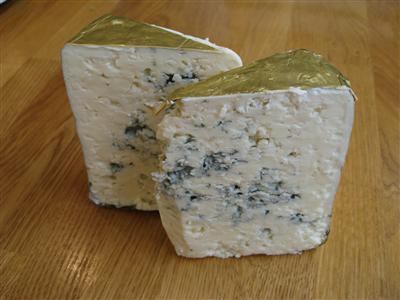


Boarding This Weekend (15 & 16th December)
in Snow talk, trip reports, Japan avalanche & backcountry
Posted
Cheese @ resorts photos!